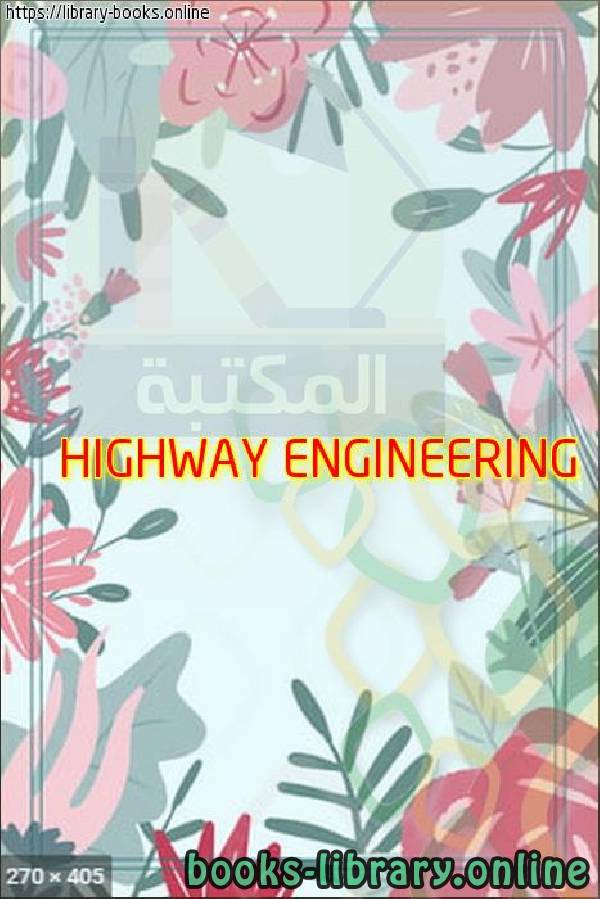كتاب HIGHWAY ENGINEERING
HIGHWAY ENGINEERING HIGHWAY ENGINEERING Martin Rogers Department of Civil and Structural Engineering Dublin Institute of Technology Ireland Blackwell s Preface, xiii Acknowledgements, xv 1 The Transportation Planning Process, 1 1.1 Why are highways so important? 1 1.2 The administration of highway schemes, 1 1.3 Sources of funding, 2 1.4 Highway planning, 3 1.4.1 Introduction, 3 1.4.2 Travel data, 4 1.4.3 Highway planning strategies, 6 1.4.4 Transportation studies, 7 1.5 The decision-making process in highway and transport planning, 9 1.5.1 Introduction, 9 1.5.2 Economic assessment, 10 1.5.3 Environmental assessment, 11 1.5.4 Public consultation, 12 1.6 Summary, 13 1.7 References, 14 2 Forecasting Future Traffic Flows, 15 2.1 Basic principles of traffic demand analysis, 15 2.2 Demand modelling, 16 2.3 Land use models, 18 2.4 Trip generation, 19 2.5 Trip distribution, 22 2.5.1 Introduction, 22 2.5.2 The gravity model, 23 2.5.3 Growth factor models, 26 2.5.4 The Furness method, 27 2.6 Modal split, 31 2.7 Traffic assignment, 34 2.8 A full example of the four-stage transportation modelling process, 36 2.8.1 Trip production, 36 2.8.2 Trip distribution, 37 2.8.3 Modal split, 40 2.8.4 Trip assignment, 41 2.9 Concluding comments, 42 2.10 References, 43 3 Scheme Appraisal for Highway Projects, 44 3.1 Introduction, 44 3.2 Economic appraisal of highway schemes, 45 3.3 Cost-benefit analysis, 46 3.3.1 Introduction, 46 3.3.2 Identifying the main project options, 46 3.3.3 Identifying all relevant costs and benefits, 48 3.3.4 Economic life, residual value and the discount rate, 50 3.3.5 Use of economic indicators to assess basic economic viability, 51 3.3.6 Highway CBA worked example, 53 3.3.7 COBA, 56 3.3.8 Advantages and disadvantages of cost-benefit analysis, 58 3.4 Payback analysis, 59 3.5 Environmental appraisal of highway schemes, 61 3.6 The new approach to appraisal (NATA), 66 3.7 Summary, 72 3.8 References, 72 4 Basic Elements of Highway Traffic Analysis, 73 4.1 Introduction, 73 4.2 Speed, flow and density of a stream of traffic, 73 4.2.1 Speed-density relationship, 74 4.2.2 Flow-density relationship, 76 4.2.3 Speed-flow relationship, 76 4.3 Determining the capacity of a highway, 78 4.4 The ‘level of service’ approach, 79 4.4.1 Introduction, 79 4.4.2 Some definitions, 80 4.4.3 Maximum service flow rates for multi-lane highways, 81 4.4.4 Maximum service flow rates for 2-lane highways, 86 4.4.5 Sizing a road using the Highway Capacity Manual approach, 90 4.5 The UK approach for rural roads, 92 4.5.1 Introduction, 92 4.5.2 Estimation of AADT for a rural road in its year of opening, 92 4.6 The UK approach for urban roads, 95 4.6.1 Introduction, 95 4.6.2 Forecast flows on urban roads, 96 viii Contents 4.7 Expansion of 12 and 16-hour traffic counts into AADT flows, 97 4.8 Concluding comments, 101 4.9 References, 101 5 The Design of Highway Intersections, 103 5.1 Introduction, 103 5.2 Deriving design reference flows from baseline traffic figures, 104 5.2.1 Existing junctions, 104 5.2.2 New junctions, 104 5.2.3 Short-term variations in flow, 104 5.2.4 Conversion of AADT to highest hourly flows, 105 5.3 Major/minor priority intersections, 105 5.3.1 Introduction, 105 5.3.2 Equations for determining capacities and delays, 110 5.3.3 Geometric layout details, 117 5.4 Roundabout intersections, 119 5.4.1 Introduction, 119 5.4.2 Types of roundabout, 120 5.4.3 Traffic capacity at roundabouts, 125 5.4.4 Geometric details, 130 5.5 Basics of traffic signal control: optimisation and delays, 132 5.5.1 Introduction, 132 5.5.2 Phasing at a signalised intersection, 133 5.5.3 Saturation flow, 133 5.5.4 Effective green time, 138 5.5.5 Optimum cycle time, 139 5.5.6 Average vehicle delays at the approach to a signalised intersection, 142 5.5.7 Average queue lengths at the approach to a signalised intersection, 144 5.5.8 Signal linkage, 146 5.6 Concluding remarks, 151 5.7 References, 151 6 Geometric Alignment and Design, 153 6.1 Basic physical elements of a highway, 153 6.2 Design speed, stopping and overtaking sight distances, 155 6.2.1 Introduction, 155 6.2.2 Urban roads, 156 6.2.3 Rural roads, 157 6.3 Geometric parameters dependent on design speed, 162 6.4 Sight distances, 163 Contents ix 6.4.1 Introduction, 163 6.4.2 Stopping sight distance, 163 6.4.3 Overtaking sight distance, 165 6.5 Horizontal alignment, 167 6.5.1 General, 167 6.5.2 Deriving the minimum radius equation, 168 6.5.3 Horizontal curves and sight distances, 170 6.5.4 Transitions, 173 6.6 Vertical alignment, 178 6.6.1 General, 178 6.6.2 K values, 179 6.6.3 Visibility and comfort criteria, 179 6.6.4 Parabolic formula, 180 6.6.5 Crossfalls, 183 6.6.6 Vertical crest curve design and sight distance requirements, 183 6.6.7 Vertical sag curve design and sight distance requirements, 189 6.7 References, 191 7 Highway Pavement Materials and Design, 192 7.1 Introduction, 192 7.2 Soils at subformation level, 194 7.2.1 General, 194 7.2.2 CBR test, 194 7.2.3 Determination of CBR using plasticity index, 197 7.3 Subbase and capping, 200 7.3.1 General, 200 7.3.2 Thickness design, 200 7.3.3 Grading of subbase and capping, 201 7.4 Traffic loading, 203 7.5 Pavement deterioration, 208 7.5.1 Flexible pavements, 208 7.5.2 Rigid pavements, 209 7.6 Materials within flexible pavements, 209 7.6.1 Bitumen, 209 7.6.2 Surface dressing and modified binders, 211 7.6.3 Recipe specifications, 213 7.6.4 Coated macadams, 214 7.6.5 Asphalts, 216 7.6.6 Aggregates, 217 7.6.7 Construction of bituminous road surfacings, 218 7.7 Materials in rigid pavements, 220 7.7.1 General, 220-
من الهندسة المدنية - مكتبة كتب الهندسة والتكنولوجيا.

قراءة كتاب HIGHWAY ENGINEERING أونلاين
معلومات عن كتاب HIGHWAY ENGINEERING:
HIGHWAY
ENGINEERING
Martin Rogers
Department of Civil and Structural Engineering
Dublin Institute of Technology
Ireland
Blackwell
s
Preface, xiii
Acknowledgements, xv
1 The Transportation Planning Process, 1
1.1 Why are highways so important? 1
1.2 The administration of highway schemes, 1
1.3 Sources of funding, 2
1.4 Highway planning, 3
1.4.1 Introduction, 3
1.4.2 Travel data, 4
1.4.3 Highway planning strategies, 6
1.4.4 Transportation studies, 7
1.5 The decision-making process in highway and transport planning, 9
1.5.1 Introduction, 9
1.5.2 Economic assessment, 10
1.5.3 Environmental assessment, 11
1.5.4 Public consultation, 12
1.6 Summary, 13
1.7 References, 14
2 Forecasting Future Traffic Flows, 15
2.1 Basic principles of traffic demand analysis, 15
2.2 Demand modelling, 16
2.3 Land use models, 18
2.4 Trip generation, 19
2.5 Trip distribution, 22
2.5.1 Introduction, 22
2.5.2 The gravity model, 23
2.5.3 Growth factor models, 26
2.5.4 The Furness method, 27
2.6 Modal split, 31
2.7 Traffic assignment, 34
2.8 A full example of the four-stage transportation modelling process, 36
2.8.1 Trip production, 36
2.8.2 Trip distribution, 37
2.8.3 Modal split, 40
2.8.4 Trip assignment, 41
2.9 Concluding comments, 42
2.10 References, 43
3 Scheme Appraisal for Highway Projects, 44
3.1 Introduction, 44
3.2 Economic appraisal of highway schemes, 45
3.3 Cost-benefit analysis, 46
3.3.1 Introduction, 46
3.3.2 Identifying the main project options, 46
3.3.3 Identifying all relevant costs and benefits, 48
3.3.4 Economic life, residual value and the discount rate, 50
3.3.5 Use of economic indicators to assess basic economic viability, 51
3.3.6 Highway CBA worked example, 53
3.3.7 COBA, 56
3.3.8 Advantages and disadvantages of cost-benefit analysis, 58
3.4 Payback analysis, 59
3.5 Environmental appraisal of highway schemes, 61
3.6 The new approach to appraisal (NATA), 66
3.7 Summary, 72
3.8 References, 72
4 Basic Elements of Highway Traffic Analysis, 73
4.1 Introduction, 73
4.2 Speed, flow and density of a stream of traffic, 73
4.2.1 Speed-density relationship, 74
4.2.2 Flow-density relationship, 76
4.2.3 Speed-flow relationship, 76
4.3 Determining the capacity of a highway, 78
4.4 The ‘level of service’ approach, 79
4.4.1 Introduction, 79
4.4.2 Some definitions, 80
4.4.3 Maximum service flow rates for multi-lane highways, 81
4.4.4 Maximum service flow rates for 2-lane highways, 86
4.4.5 Sizing a road using the Highway Capacity Manual approach, 90
4.5 The UK approach for rural roads, 92
4.5.1 Introduction, 92
4.5.2 Estimation of AADT for a rural road in its year of opening, 92
4.6 The UK approach for urban roads, 95
4.6.1 Introduction, 95
4.6.2 Forecast flows on urban roads, 96
viii Contents
4.7 Expansion of 12 and 16-hour traffic counts into AADT flows, 97
4.8 Concluding comments, 101
4.9 References, 101
5 The Design of Highway Intersections, 103
5.1 Introduction, 103
5.2 Deriving design reference flows from baseline traffic figures, 104
5.2.1 Existing junctions, 104
5.2.2 New junctions, 104
5.2.3 Short-term variations in flow, 104
5.2.4 Conversion of AADT to highest hourly flows, 105
5.3 Major/minor priority intersections, 105
5.3.1 Introduction, 105
5.3.2 Equations for determining capacities and delays, 110
5.3.3 Geometric layout details, 117
5.4 Roundabout intersections, 119
5.4.1 Introduction, 119
5.4.2 Types of roundabout, 120
5.4.3 Traffic capacity at roundabouts, 125
5.4.4 Geometric details, 130
5.5 Basics of traffic signal control: optimisation and delays, 132
5.5.1 Introduction, 132
5.5.2 Phasing at a signalised intersection, 133
5.5.3 Saturation flow, 133
5.5.4 Effective green time, 138
5.5.5 Optimum cycle time, 139
5.5.6 Average vehicle delays at the approach to a signalised
intersection, 142
5.5.7 Average queue lengths at the approach to a signalised
intersection, 144
5.5.8 Signal linkage, 146
5.6 Concluding remarks, 151
5.7 References, 151
6 Geometric Alignment and Design, 153
6.1 Basic physical elements of a highway, 153
6.2 Design speed, stopping and overtaking sight distances, 155
6.2.1 Introduction, 155
6.2.2 Urban roads, 156
6.2.3 Rural roads, 157
6.3 Geometric parameters dependent on design speed, 162
6.4 Sight distances, 163
Contents ix
6.4.1 Introduction, 163
6.4.2 Stopping sight distance, 163
6.4.3 Overtaking sight distance, 165
6.5 Horizontal alignment, 167
6.5.1 General, 167
6.5.2 Deriving the minimum radius equation, 168
6.5.3 Horizontal curves and sight distances, 170
6.5.4 Transitions, 173
6.6 Vertical alignment, 178
6.6.1 General, 178
6.6.2 K values, 179
6.6.3 Visibility and comfort criteria, 179
6.6.4 Parabolic formula, 180
6.6.5 Crossfalls, 183
6.6.6 Vertical crest curve design and sight distance requirements, 183
6.6.7 Vertical sag curve design and sight distance requirements, 189
6.7 References, 191
7 Highway Pavement Materials and Design, 192
7.1 Introduction, 192
7.2 Soils at subformation level, 194
7.2.1 General, 194
7.2.2 CBR test, 194
7.2.3 Determination of CBR using plasticity index, 197
7.3 Subbase and capping, 200
7.3.1 General, 200
7.3.2 Thickness design, 200
7.3.3 Grading of subbase and capping, 201
7.4 Traffic loading, 203
7.5 Pavement deterioration, 208
7.5.1 Flexible pavements, 208
7.5.2 Rigid pavements, 209
7.6 Materials within flexible pavements, 209
7.6.1 Bitumen, 209
7.6.2 Surface dressing and modified binders, 211
7.6.3 Recipe specifications, 213
7.6.4 Coated macadams, 214
7.6.5 Asphalts, 216
7.6.6 Aggregates, 217
7.6.7 Construction of bituminous road surfacings, 218
7.7 Materials in rigid pavements, 220
7.7.1 General, 220
عدد مرات التحميل : 12034 مرّة / مرات.
تم اضافته في : الخميس , 22 مارس 2018م.
حجم الكتاب عند التحميل : 17.9 ميجا بايت .
تعليقات ومناقشات حول الكتاب:
HIGHWAY ENGINEERING
HIGHWAY
ENGINEERING
Martin Rogers
Department of Civil and Structural Engineering
Dublin Institute of Technology
Ireland
Blackwell
s
Preface, xiii
Acknowledgements, xv
1 The Transportation Planning Process, 1
1.1 Why are highways so important? 1
1.2 The administration of highway schemes, 1
1.3 Sources of funding, 2
1.4 Highway planning, 3
1.4.1 Introduction, 3
1.4.2 Travel data, 4
1.4.3 Highway planning strategies, 6
1.4.4 Transportation studies, 7
1.5 The decision-making process in highway and transport planning, 9
1.5.1 Introduction, 9
1.5.2 Economic assessment, 10
1.5.3 Environmental assessment, 11
1.5.4 Public consultation, 12
1.6 Summary, 13
1.7 References, 14
2 Forecasting Future Traffic Flows, 15
2.1 Basic principles of traffic demand analysis, 15
2.2 Demand modelling, 16
2.3 Land use models, 18
2.4 Trip generation, 19
2.5 Trip distribution, 22
2.5.1 Introduction, 22
2.5.2 The gravity model, 23
2.5.3 Growth factor models, 26
2.5.4 The Furness method, 27
2.6 Modal split, 31
2.7 Traffic assignment, 34
2.8 A full example of the four-stage transportation modelling process, 36
2.8.1 Trip production, 36
2.8.2 Trip distribution, 37
2.8.3 Modal split, 40
2.8.4 Trip assignment, 41
2.9 Concluding comments, 42
2.10 References, 43
3 Scheme Appraisal for Highway Projects, 44
3.1 Introduction, 44
3.2 Economic appraisal of highway schemes, 45
3.3 Cost-benefit analysis, 46
3.3.1 Introduction, 46
3.3.2 Identifying the main project options, 46
3.3.3 Identifying all relevant costs and benefits, 48
3.3.4 Economic life, residual value and the discount rate, 50
3.3.5 Use of economic indicators to assess basic economic viability, 51
3.3.6 Highway CBA worked example, 53
3.3.7 COBA, 56
3.3.8 Advantages and disadvantages of cost-benefit analysis, 58
3.4 Payback analysis, 59
3.5 Environmental appraisal of highway schemes, 61
3.6 The new approach to appraisal (NATA), 66
3.7 Summary, 72
3.8 References, 72
4 Basic Elements of Highway Traffic Analysis, 73
4.1 Introduction, 73
4.2 Speed, flow and density of a stream of traffic, 73
4.2.1 Speed-density relationship, 74
4.2.2 Flow-density relationship, 76
4.2.3 Speed-flow relationship, 76
4.3 Determining the capacity of a highway, 78
4.4 The ‘level of service’ approach, 79
4.4.1 Introduction, 79
4.4.2 Some definitions, 80
4.4.3 Maximum service flow rates for multi-lane highways, 81
4.4.4 Maximum service flow rates for 2-lane highways, 86
4.4.5 Sizing a road using the Highway Capacity Manual approach, 90
4.5 The UK approach for rural roads, 92
4.5.1 Introduction, 92
4.5.2 Estimation of AADT for a rural road in its year of opening, 92
4.6 The UK approach for urban roads, 95
4.6.1 Introduction, 95
4.6.2 Forecast flows on urban roads, 96
viii Contents
4.7 Expansion of 12 and 16-hour traffic counts into AADT flows, 97
4.8 Concluding comments, 101
4.9 References, 101
5 The Design of Highway Intersections, 103
5.1 Introduction, 103
5.2 Deriving design reference flows from baseline traffic figures, 104
5.2.1 Existing junctions, 104
5.2.2 New junctions, 104
5.2.3 Short-term variations in flow, 104
5.2.4 Conversion of AADT to highest hourly flows, 105
5.3 Major/minor priority intersections, 105
5.3.1 Introduction, 105
5.3.2 Equations for determining capacities and delays, 110
5.3.3 Geometric layout details, 117
5.4 Roundabout intersections, 119
5.4.1 Introduction, 119
5.4.2 Types of roundabout, 120
5.4.3 Traffic capacity at roundabouts, 125
5.4.4 Geometric details, 130
5.5 Basics of traffic signal control: optimisation and delays, 132
5.5.1 Introduction, 132
5.5.2 Phasing at a signalised intersection, 133
5.5.3 Saturation flow, 133
5.5.4 Effective green time, 138
5.5.5 Optimum cycle time, 139
5.5.6 Average vehicle delays at the approach to a signalised
intersection, 142
5.5.7 Average queue lengths at the approach to a signalised
intersection, 144
5.5.8 Signal linkage, 146
5.6 Concluding remarks, 151
5.7 References, 151
6 Geometric Alignment and Design, 153
6.1 Basic physical elements of a highway, 153
6.2 Design speed, stopping and overtaking sight distances, 155
6.2.1 Introduction, 155
6.2.2 Urban roads, 156
6.2.3 Rural roads, 157
6.3 Geometric parameters dependent on design speed, 162
6.4 Sight distances, 163
Contents ix
6.4.1 Introduction, 163
6.4.2 Stopping sight distance, 163
6.4.3 Overtaking sight distance, 165
6.5 Horizontal alignment, 167
6.5.1 General, 167
6.5.2 Deriving the minimum radius equation, 168
6.5.3 Horizontal curves and sight distances, 170
6.5.4 Transitions, 173
6.6 Vertical alignment, 178
6.6.1 General, 178
6.6.2 K values, 179
6.6.3 Visibility and comfort criteria, 179
6.6.4 Parabolic formula, 180
6.6.5 Crossfalls, 183
6.6.6 Vertical crest curve design and sight distance requirements, 183
6.6.7 Vertical sag curve design and sight distance requirements, 189
6.7 References, 191
7 Highway Pavement Materials and Design, 192
7.1 Introduction, 192
7.2 Soils at subformation level, 194
7.2.1 General, 194
7.2.2 CBR test, 194
7.2.3 Determination of CBR using plasticity index, 197
7.3 Subbase and capping, 200
7.3.1 General, 200
7.3.2 Thickness design, 200
7.3.3 Grading of subbase and capping, 201
7.4 Traffic loading, 203
7.5 Pavement deterioration, 208
7.5.1 Flexible pavements, 208
7.5.2 Rigid pavements, 209
7.6 Materials within flexible pavements, 209
7.6.1 Bitumen, 209
7.6.2 Surface dressing and modified binders, 211
7.6.3 Recipe specifications, 213
7.6.4 Coated macadams, 214
7.6.5 Asphalts, 216
7.6.6 Aggregates, 217
7.6.7 Construction of bituminous road surfacings, 218
7.7 Materials in rigid pavements, 220
7.7.1 General, 220
HIGHWAY ENGINEERING
highway engineering pdf
highway engineering books
highway design pdf
rigid pavement
 مهلاً !
مهلاً !قبل تحميل الكتاب .. يجب ان يتوفر لديكم برنامج تشغيل وقراءة ملفات pdf
يمكن تحميلة من هنا 'تحميل البرنامج'

نوع الكتاب : pdf.
اذا اعجبك الكتاب فضلاً اضغط على أعجبني و يمكنك تحميله من هنا:











